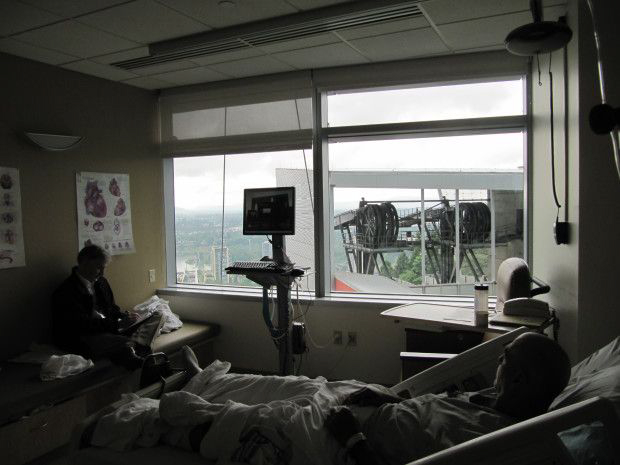PORTLAND — In 1992, the federal government told drug manufacturers they had to give hospitals steep discounts if a large percentage of their patients were elderly or low-income.
It was a money-saver for hospitals and the federal government, and the program has grown in leaps and bounds.
But drug manufacturers say the program is now bloated and badly regulated.
The feds are about to issue new rules for it, so there’s some fervent lobbying going on.
When the first Bush Administration set up the drug discount program, it had wide bipartisan support. But the name Drug Discount Program must have been taken because they chose a more cryptic moniker: The 340B program.
Essentially, the 340B program helps the federal government stretch its Medicaid and Medicare dollars. And it allows hospitals to give its poor and vulnerable patients a break, even if they’re not enrolled in Medicaid or Medicare.
Outside David Chance’s hospital room at Oregon Health & Science University, a volunteer plays a dulcimer to help him feel better.
A few days ago, Chance turned up here saying every time he lays down, it was hard to breathe.
“They put a catheter in the vein in my leg that goes up to my heart, injected some dye so they could see the circulations around and in the vessels around the heart,” he said.
It turns out, Chance has an enlarged heart and a valve that doesn’t close properly.
“Yeah, I’ll be changing my diet and on prescriptions for a little while,” he said.
Those prescriptions include aspirin, a statin and warfarin at a cost of about $125 a month.
But Chance works at a Portland-area call center and doesn’t have health insurance. So under the 340B Program, OHSU is giving him the first month of his prescription free.
“Yeah, it’s great. I’d probably be having difficulties affording them otherwise,” said Chance.
Drug companies don’t have a problem with cases like this.
But they are upset that sometimes, instead of passing on drug discounts to patients, hospitals are selling the drugs at higher prices, then using the proceeds to open clinics and hire staff.
“That’s not what the program was designed for,” said Stephanie Silverman is with the Alliance for Integrity and Reform of 340B, a lobbying group made up of drug companies and medical organizations. “It was not designed to provide other revenues to support the operations of hospitals.”
“I would query whether the majority of hospitals are actually passing drugs through at the lower costs that they claim. And we would dispute the presumption that the funds from the savings are intended to offset the operating costs of the hospitals at all. That’s not what they’re for. “
But Joe Fazio, assistant director of Pharmacy Services at OHSU, says clinics and staff are essential because some drugs can’t simply be handed over to patients.
Doctors and nurses are need to supervise when it comes to something like chemotherapy drugs.
“The ones we’re talking about are the ones injected into your veins and they can take several hours to infuse for a single course of therapy and this can happen for five, six days a week at six weeks at a time. So it’s very intense, there’s side effects that it’s important to have a nurse there and a doctor,” he said.
Fazio says the benefits of the 340B drug program cannot be overstated.
“Overall, it reduces our cost of doing business by 20 percent.,” he said.
And to secure those savings he says, OHSU provides almost $400 million a year in charity care, community programs and education.
Of the 70 or so hospitals in Oregon, about 30 qualify for the 340B program.
Drug makers say those numbers have ballooned in recent years and the program needs to be better controlled.
For example, says Stephanie Silverman of the Reform 340B Alliance, many hospitals have been buying up non-qualifying clinics — then bringing them under their umbrellas.
“Hospitals are not only trying to maximize their own 340B revenues, they’re looking to acquire, and they are acquiring many community oncology practices, putting them in their system,” said Silverman.
“And by doing so they can all of a sudden tap into new revenues they couldn’t get before.”
Joe Fazio is the assistant pharmacy director at OHSU.
“I wouldn’t go so far as saying there are hospitals gaming the system.” he said. “But this is an incredibly complex program. I will say that there are institutions out there that maybe don’t understand all the rules.”
One of the things both the hospitals and the drug manufacturers can agree on, is that the federal government needs to re-write the 340B rules.
“So I’m looking forward to greater clarification, less wiggle room around how we interpret,” said Fazio.
One of the biggest issues to be dealt with, is the definition of “patient.”
“There has been relatively little clarity in regulatory guidance about which patient qualifies,” said Silverman.
“Who’s uninsured and qualifies as indigent by which measure. There are different kinds of health economics measures that have been established through different iterations of federal policy making.”
The federal Health Resources and Services Administration is expected to unveil new rules for the program this month.
It’s worth noting that the feds tried to tighten the rules in 2007. But there was such a backlash the proposal was quietly retracted a few years later.
Now the feds are back for round two.



